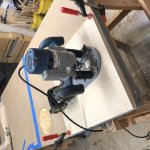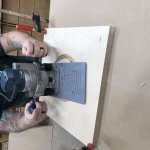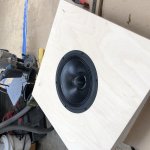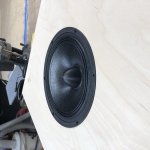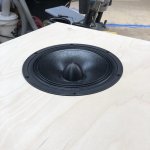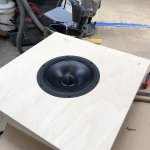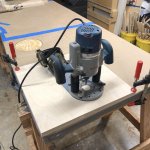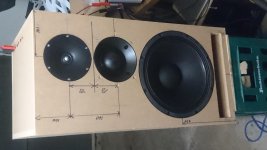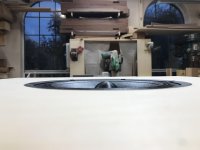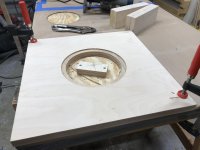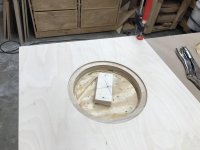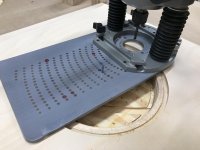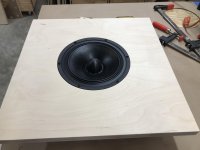sorry for the abscent 🙂 yesterday I met up with Gable to work on the inserts, he got most of the work done already, so I was just a guest and watching the progress 😀 Unfortunately I couldn't stay long and had to leave early but we manage to finish the TD8M insert, Gable is a very detailed guy and I m sure this will turn out pretty accurate. Thanks again Gable for your generous help and hospitality 🙂 attached is some beforee and after pics. EDIT: sorry for 90Degree CCW pics, not sure why, but i ll try to fix it.
Attachments
You're very welcome, I'm happy to help.
I hope to finish the td8 and td15 insert this weekend, I might get some time to work on the waveguide insert as well, we'll see.
Cheers,
Gable
I hope to finish the td8 and td15 insert this weekend, I might get some time to work on the waveguide insert as well, we'll see.
Cheers,
Gable
Attachments
Hard to see in the pictures, but I need to route the mounting recess down another 1-1.5mm to get it perfectly flush. It's on the todo list.
With the rubber cover on the TD15, should I make the mounting recess deep enough so that it's flush with the top of that cover?
I ask, because I presume the outer rubber gasket/cover will squish down some at the mounting bolt locations.
I'll take some up-close pictures later tonight.
Cheers,
Gable
With the rubber cover on the TD15, should I make the mounting recess deep enough so that it's flush with the top of that cover?
I ask, because I presume the outer rubber gasket/cover will squish down some at the mounting bolt locations.
I'll take some up-close pictures later tonight.
Cheers,
Gable
Gable,
For woofer and midrange the flush mounting is less critical, because these drivers become directive at higher frequencies. If you keep it lower than 1 mm, it is ok.
I have the same problem with an Accuton C173 midrange, there is also a rubber against the gasket. I made the mounting recess 1 mm deeper, just for good looking.
For a dome tweeter with wide radiation it is more important. 1mm can cause already some ripple around a few kHz. With the horn tweeter it is also less critical.
Your work looks very professional.
For woofer and midrange the flush mounting is less critical, because these drivers become directive at higher frequencies. If you keep it lower than 1 mm, it is ok.
I have the same problem with an Accuton C173 midrange, there is also a rubber against the gasket. I made the mounting recess 1 mm deeper, just for good looking.
For a dome tweeter with wide radiation it is more important. 1mm can cause already some ripple around a few kHz. With the horn tweeter it is also less critical.
Your work looks very professional.
Last edited:
pcbgab, grats for the professinal.
While you publish some photo do you mind to share some tips and recomendations about how to proper use a router and get good finishing results.
While you publish some photo do you mind to share some tips and recomendations about how to proper use a router and get good finishing results.
mind to share some tips and recomendations about how to proper use a router and get good finishing results.
All you need is a circle jig, patience, some practice, a proper workbench, and maybe some tatoos (optional). I am at the circle jig level 😀.
Photos!! 🙂
Open Source Monkey Coffin prototype. Quick and dirty box, but interesting project...
Attachments
Looks very good already for a prototype, interesting yes, with high expectationsOpen Source Monkey Coffin prototype. Quick and dirty box, but interesting project...
All you need is a circle jig, patience, some practice, a proper workbench, and maybe some tatoos (optional). I am at the circle jig level 😀.
+1
I'm going to adjust the td8 insert tonight, I'll take some detail pictures of that process and post them here.
Gable,
For woofer and midrange the flush mounting is less critical, because these drivers become directive at higher frequencies. If you keep it lower than 1 mm, it is ok.
I have the same problem with an Accuton C173 midrange, there is also a rubber against the gasket. I made the mounting recess 1 mm deeper, just for good looking.
For a dome tweeter with wide radiation it is more important. 1mm can cause already some ripple around a few kHz. With the horn tweeter it is also less critical.
Your work looks very professional.
Thank you!
I will likely do the same for the td15, as you did with your Accuton midrange.
Cheers,
Gable
Gable that is awesome ,can't wait to see more pics.
good to know that we do not need to worry about the drivers being totally flushed but I know Gable is more detail oriented than that to let it go 😀
mbrennwa, that looks killer!, very very tempted to build one 🙂 can wait to see what magic you gonna do on the finish, perhaps another brass sheet over it ? ( that one looked stunning ).
good to know that we do not need to worry about the drivers being totally flushed but I know Gable is more detail oriented than that to let it go 😀
mbrennwa, that looks killer!, very very tempted to build one 🙂 can wait to see what magic you gonna do on the finish, perhaps another brass sheet over it ? ( that one looked stunning ).
Last edited:
Open Source Monkey Coffin prototype. Quick and dirty box, but interesting project...
I haven't kept up with that thread, what drivers are those?
I haven't kept up with that thread, what drivers are those?
Faital 12PR320 woofer, Volt VM752 mid, and ScanSpeak R2904 in a Visaton WG148 waveguide. The tweeter choice + waveguide is not yet finalized.
Faital 12PR320 woofer, Volt VM752 mid, and ScanSpeak R2904 in a Visaton WG148 waveguide. The tweeter choice + waveguide is not yet finalized.
That's quite a nice compliment of drivers.
I like the speaker input jacks on the top of the cabinet for each driver. Great idea for prototyping crossovers, etc.
Cheers,
Gable
I wrapped up the insert for the TD8, got it flush like I wanted.
The mounting ring has a slight flare that makes the transition from cone to baffle even more smooth. Very well thought out driver.
Yes, my machinist square is dirty, I could sand it clean, but there's more important things in life..... single malt comes to mind. 😀
The mounting ring has a slight flare that makes the transition from cone to baffle even more smooth. Very well thought out driver.
Yes, my machinist square is dirty, I could sand it clean, but there's more important things in life..... single malt comes to mind. 😀
Attachments
Someone asked for some how to pictures, so I'll post a few and a quick description of the process I used to make the recess for the TD8 the proper depth.
Since I had already cut the round insert out, I needed to screw a block down and draw the centerlines across it. When I'm routing a baffle, I always do my best to remember to leave the center witness marks on the baffle until I'm completely done routing the recess and cutouts. That way if I need to adjust the size of any of them, I can clamp the piece down, screw down a block, run a straight edge across the centerlines and I have my center pivot position once again.
Once I do that, I'll generally set the bit depth with a ruler to get close. I'll cut a little bit in some scrap and measure again, once I like that measurement, I set the depth stop on the plunge base and route the work piece.
You can see some blue marks on the circle guide. The first one is the outer most dimension and the second one is the inside, or cutout dimension. I can make a pass with the router, jump a few spots down the circle guide, route, repeat, until I get to the final mark.
Then clean up the burrs on the edge and drop the driver in to check for alignment.
With the circle guide and a small amount of prep work, it's easy to route a nice, flush recess for your driver(s).
Cheers,
Gable
Since I had already cut the round insert out, I needed to screw a block down and draw the centerlines across it. When I'm routing a baffle, I always do my best to remember to leave the center witness marks on the baffle until I'm completely done routing the recess and cutouts. That way if I need to adjust the size of any of them, I can clamp the piece down, screw down a block, run a straight edge across the centerlines and I have my center pivot position once again.
Once I do that, I'll generally set the bit depth with a ruler to get close. I'll cut a little bit in some scrap and measure again, once I like that measurement, I set the depth stop on the plunge base and route the work piece.
You can see some blue marks on the circle guide. The first one is the outer most dimension and the second one is the inside, or cutout dimension. I can make a pass with the router, jump a few spots down the circle guide, route, repeat, until I get to the final mark.
Then clean up the burrs on the edge and drop the driver in to check for alignment.
With the circle guide and a small amount of prep work, it's easy to route a nice, flush recess for your driver(s).
Cheers,
Gable
Attachments
- Home
- Loudspeakers
- Multi-Way
- Open Source "Tower XL"
